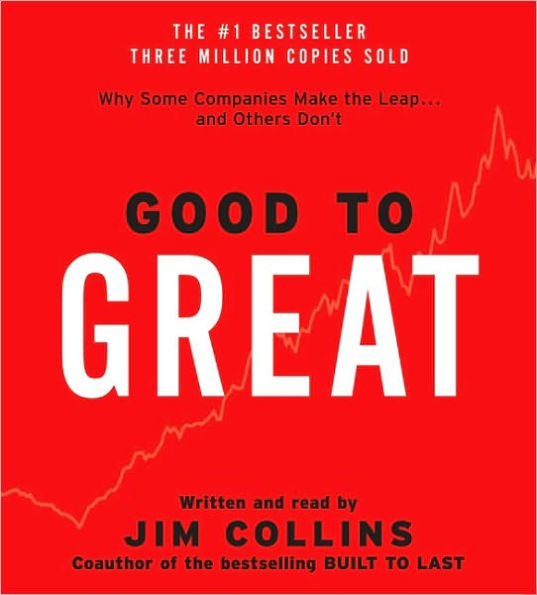Read an Excerpt
Chapter One
Good is the Enemy of Great
That's what makes death so hard -- unsatisfied curiosity.
--Beryl Markham,
West with the NightGood is the enemy of great.
And that is one of the key reasons why we have so little that becomes great.
We don't have great schools, principally because we have good schools. We don't have great government, principally because we have good government. Few people attain great lives, in large part because it is just so easy to settle for a good life. The vast majority of companies never become great, precisely because the vast majority become quite good -- and that is their main problem.
This point became piercingly clear to me in 1996, when I was having dinner with a group of thought leaders gathered for a discussion about organizational performance. Bill Meehan, the managing director of the San Francisco office of McKinsey & Company, leaned over and casually confided, "You know, Jim, we love Built to Last around here. You and your coauthor did a very fine job on the research and writing. Unfortunately, it's useless."
Curious, I asked him to explain.
"The companies you wrote about were, for the most part, always great," he said. "They never had to turn themselves from good companies into great companies. They had parents like David Packard and George Merck, who shaped the character of greatness from early on. But what about the vast majority of companies that wake up partway through life and realize that they're good, but not great?"
I now realize that Meehan was exaggerating for effect with his "useless" comment, but his essential observation was correct -- that truly great companies, for the most part, have always been great. And the vast majority of good companies remain just that -- good, but not great. Indeed, Meehan's comment proved to be an invaluable gift, as it planted the seed of a question that became the basis of this entire book -- namely, Can a good company become a great company and, if so, how? Or is the disease of "just being good" incurable?
Five years after that fateful dinner we can now say, without question, that good to great does happen, and we've learned much about the underlying variables that make it happen. Inspired by Bill Meehan's challenge, my research team and I embarked on a five-year research effort, a journey to explore the inner workings of good to great.
In essence, we identified companies that made the leap from good results to great results and sustained those results for at least fifteen years. We compared these companies to a carefully selected control group of comparison companies that failed to make the leap, or if they did, failed to sustain it. We then compared the good-to-great companies to the comparison companies to discover the essential and distinguishing factors at work.
The good-to-great examples that made the final cut into the study attained extraordinary results, averaging cumulative stock returns 6.9 times the general market in the fifteen years following their transition points. To put that in perspective, General Electric (considered by many to be the best-led company in America at the end of the twentieth century) outperformed the market by 2.8 times over the fifteen years 1985 to 2000. Furthermore, if you invested $1 in a mutual fund of the good-to-great companies in 1965, holding each company at the general market rate until the date of transition, and simultaneously invested $1 in a general market stock fund, your $1 in the good-to-great fund taken out on January 1, 2000, would have multiplied 471 times, compared to a 56 fold increase in the market.
These are remarkable numbers, made all the more remarkable when you consider the fact that they came from companies that had previously been so utterly unremarkable. Consider just one case, Walgreens. For over forty years, Walgreens had bumped along as a very average company, more or less tracking the general market. Then in 1975, seemingly out of nowhere -- bang! -- Walgreens began to climb...and climb...and climb...and climb...and it just kept climbing. From December 31, 1975, to January 1, 2000, $1 invested in Walgreens beat $1 invested in technology superstar Intel by nearly two times, General Electric by nearly five times, Coca-Cola by nearly eight times, and the general stock market (including the NASDAQ stock run-up at the end of 1999) by over fifteen times.
How on earth did a company with such a long history of being nothing special transform itself into an enterprise that outperformed some of the best-led organizations in the world? And why was Walgreens able to make the leap when other companies in the same industry with the same opportunities and similar resources, such as Eckerd, did not make the leap? This single case captures the essence of our quest.
This book is not about Walgreens per se, or any of the specific companies we studied. It is about the question -- Can a good company become a great company and, if so, how? -- and our search for timeless, universal answers that can be applied by any organization.
Our five-year quest yielded many insights, a number of them surprising and quite contrary to conventional wisdom, but one giant conclusion stands above the others: We believe that almost any organization can substantially improve its stature and performance, perhaps even become great, if it conscientiously applies the framework of ideas we've uncovered.
This book is dedicated to teaching what we've learned. The remainder of this introductory chapter tells the story of our journey, outlines our research method, and previews the key findings. In chapter 2, we launch headlong into the findings themselves, beginning with one of the most provocative of the whole study: Level 5 leadership.
Undaunted CuriosityPeople often ask, "What motivates you to undertake these huge research projects?" It's a good question. The answer is, "Curiosity."...


